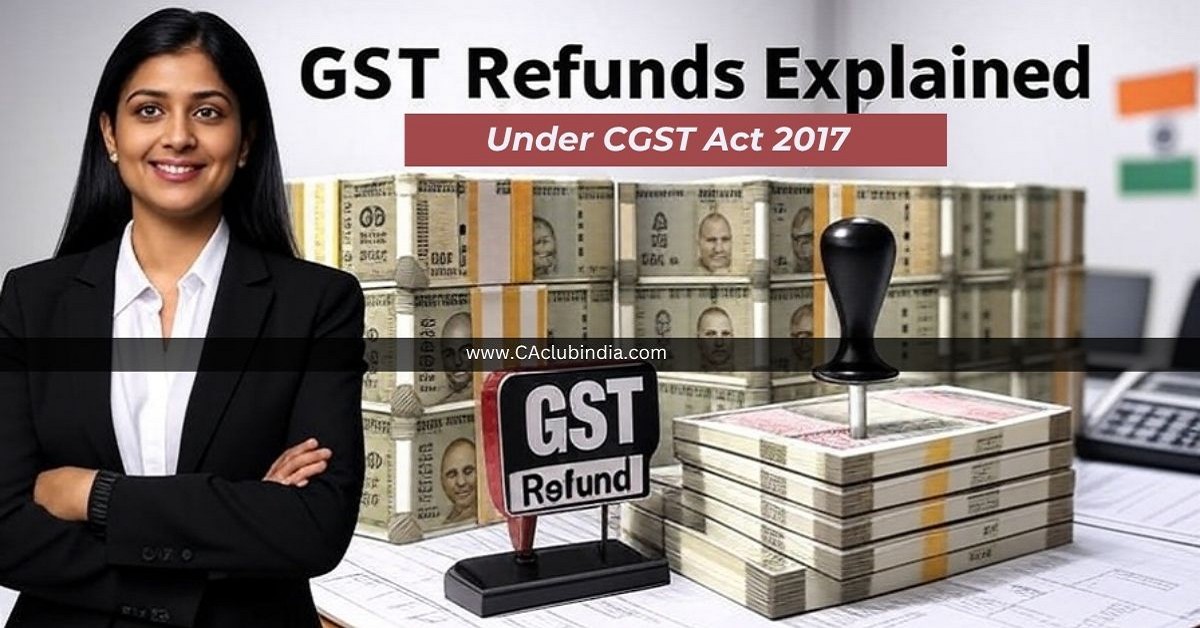Introduction
The Goods and Services Tax (GST) regime, implemented in India from July 1, 2017, revolutionized the country's indirect taxation landscape. Among its many features, the refund mechanism under the Central Goods and Services Tax (CGST) Act, 2017, stands out as a vital tool for ensuring liquidity, preventing the cascading effect of taxes, and promoting ease of doing business. As GST continues to evolve, the refund process has seen as significant procedural and technological advancements, especially with recent changes in 2025.

Understanding Refunds under the CGST Act, 2017
A refund as per the CGST Act, 2017, refers to the return of excess tax, interest, or any other amount paid by a taxpayer, or the reimbursement of unutilized Input Tax Credit (ITC) under the specified circumstances. Section 54 of the CGST Act, 2017, is the cornerstone provision whichgoverns the refunds. The provision aims to ensure that taxes do not become a cost to businesses, especially in cases like exports or inverted duty structures, thereby supporting the principle of tax neutrality.
Refunds can be claimed in the following cases:
- Excess payment of tax due to error or oversight
- Exports of goods or services (zero-rated supplies)
- Supplies to Special Economic Zones (SEZs)
- Deemed exports
- Accumulation of ITC due to inverted duty structure
- Finalization of provisional assessments
- Refunds to embassies or international organizations
- Refund of excess balance in the electronic cash ledger
Importance of Claiming Refunds under GST
The timely and efficient processing of GST refunds is crucial for several reasons:
- Business Liquidity: Refunds ensure that the working capital is not unnecessarily blocked, especially for exporters and businesses with high input costs.
- Export Competitiveness: Treating exports as zero-rated supplies and allowing prompt refunds of taxes paid.It enhances the global competitiveness of Indian exporters and increases the level of exports.
- Trust and Compliance: A transparent and predictable refund mechanism builds taxpayer trust and encourages voluntary compliance.
- Ease of Doing Business: Streamlined refund procedures contribute to India's standing in global ease of doing business rankings.
For instance, an exporter who pays IGST on exported goods can claim a refund of the tax paid, ensuring that the exported goods are tax-free in the hands of the foreign buyer. Similarly, a manufacturer facing an inverted duty structure (where input tax rates are higher than output tax rates) can claim a refund of accumulated ITC, thus maintaining cash flow.
Cases Eligible for GST Refunds
The Central Goods and Services (CGST) Act, 2017 along with the Integrated Goods and Services (IGST) and State Goods and Services (SGST) Acts, provides for refunds in a variety of scenarios. The most common cases include:
- Exports of Goods or Services: Exports are treated as zero-rated supplies. Taxpayers can claim a refund of IGST paid on exports or unutilized ITC if exports are made without payment of tax.
- Supplies to SEZ Units/Developers: Supplies to SEZs are also zero-rated supplies. Refunds can be claimed either for IGST paid or for unutilized ITC on such supplies made.
- Deemed Exports: Certain supplies are notified as deemed exports (e.g., supplies to Export Oriented Units) are eligible for refund of taxes paid.
- Inverted Duty Structure: When the rate of tax paid on inputs is higher than the rate of tax paid on output supplies, resulting in accumulation of ITC, a refund can be claimed for the unutilized input tax credit.
- Excess Payment of Tax: If a taxpayer pays more tax than required due to calculation errors or wrong classification, the excess amount can be claimed as a refund.
- Finalization of Provisional Assessment: If the final assessment results in a lower tax liability than provisionally assessed, the excess paid is refundable.
- Refund of Excess Balance in Electronic Cash Ledger: Any surplus balance in the electronic cash ledger can be claimed as a refund.
- Refunds to Embassies, UN Bodies, and International Organizations: Such entities can claim refunds of GST paid on the purchases, made, subject to some prescribed conditions mentioned in the notification number "16/2017-Central Tax (Rate)"and ". 13/2017-Integrated Tax (Rate)".
- Tax Paid on Intra-State Supply later held as Inter-State (and vice versa): If a supply is wrongly classified and tax is paid under the wrong head, the taxpayer can claim a refund of the tax paid and pay the correct tax.
Procedure and Statutory Framework for Claiming GST Refunds
Statutory Provisions
- Section 54 of the CGST Act, 2017: Governs the general provisions for refunds, including eligibility, time limits, and procedures.
- Section 77 of the CGST Act: Deals with refunds in cases of wrong classification of supply (intra-state vs. inter-state).
- Section 56: Mandates payment of interest if the refund is not granted within 60 days from the date of receipt of the application.
- Relevant Rules: Refund Rules under the CGST Rules, 2017, provide detailed procedures and documentation requirements.
Time Limits
Refund applications must generally be filed within two years from the relevant date. The definition of "relevant date" varies depending on the nature of the refund claim (e.g., date of export, date of payment, date of final assessment, etc.).
Step-by-Step Refund Application Process
- Pre-Application Form:
- Taxpayers must first file a pre-application form online, providing business, Aadhaar, income tax, and export details. This form is non-editable once submitted, so accuracy is crucial.
- Filing of Form RFD-01:
- The primary application for most refunds is made through Form GST RFD-01 on the GST portal. The taxpayer selects the refund category and uploads required statements and supporting documents (e.g., invoices, shipping bills, bank realization certificates).
- Uploading Invoices and Statements:
- For exports, SEZ supplies, and deemed exports, taxpayers must upload invoice-wise details in prescribed statements (Statement 2 for exports, 4 for SEZ, 5B for deemed exports). The portal now follows an invoice-based approach, enhancing accuracy and reducing duplication.
- Supporting Documents:
- Up to 10 supporting documents (maximum 5 MB each) can be uploaded, including declarations and undertakings as required by law.
- Bank Account Details:
- Taxpayers must provide valid bank account details for credit of the refund amount.
- Submission and Acknowledgement:
- The application is submitted using Digital Signature Certificate (DSC) or Electronic Verification Code (EVC). An Application Reference Number (ARN) is generated for tracking purposes.
- Processing by Authorities:
- The refund application is assigned to a jurisdictional officer for scrutiny and verification. The officer may request additional information or issue a deficiency memo if required.
- Sanction and Disbursement:
- Once approved, the refund is credited to the taxpayer's bank account. If not sanctioned within 60 days, interest is payable to the applicant.
Note: Exporters must ensure that Table 6A of GSTR-1 (export details) and Table 3.1(b) of GSTR-3B are correctly filled and filed for the same tax period. The IGST amount in GSTR-3B should be equal to or greater than that declared in GSTR-1.
Conclusion
The GST refund mechanism, as envisaged under the CGST Act, 2017 and is a cornerstone of India's indirect tax system, designed to ensure tax neutrality, promote exports, and support business liquidity. With continuous digital enhancements, such as the shift to invoice-based refund filing and stricter compliance requirements, the process is becoming more transparent, efficient, and taxpayer-friendly.
For professionals and businesses alike, understanding the eligibility, procedural nuances, and statutory framework of GST refunds is essential for effective tax management. Staying updated with the latest notifications, circulars, and amendments is equally important to maximize benefits and ensure compliance.








 CAclubindia
CAclubindia

